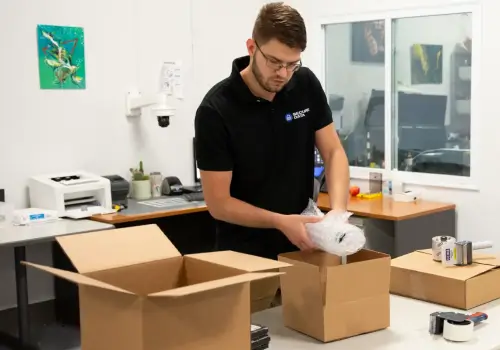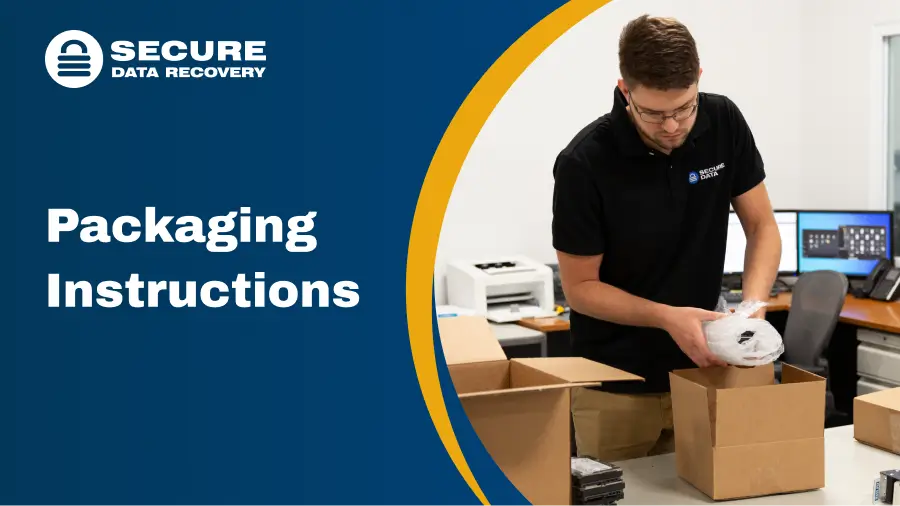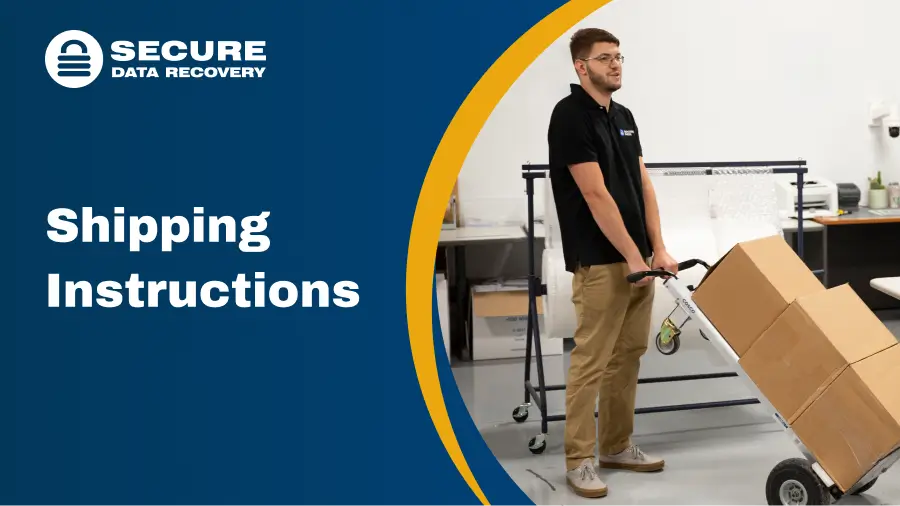
Packaging and Shipping Hard Drives To Protect Your Data
Hard disk drives (HDDs) and other storage media are complex devices with unique packaging and shipping needs. Modern devices are vulnerable to electrostatic discharge (ESD) and physical damage from sudden impacts or vibration. Therefore, protecting these devices against shocks during transit is critical to maximizing the odds of successful data recovery. This step-by-step guide will help you safely pack and ship your hard drive or another device for data recovery services.
Why Packaging and Shipping Makes a Difference
Here’s how the packaging and shipping process affects your case:
- Proper packaging prevents further damage to failed HDDs, solid-state drives (SSDs), and storage like smartphones, media cards, or USB sticks.
- Even minor shocks and vibrations could damage electronic components or magnetic platters.
- Using the appropriate packaging materials and cardboard box can shelter the device from hazards like dust, debris, and moisture.
- A drive that suffers severe damage during shipping could result in permanent data loss.
Packaging Instructions

Ensure your storage device can withstand the rigors of shipping by following these packaging tips.
Step 1: Gather Materials
To safely pack your hard drive, you will need:
- Anti-static bag
- Bubble wrap
- Packing foam
- A sturdy box
You can find anti-static bags at many electronics retailers. Home improvement and office supply stores often have packing foam for small items. If time is not a factor, you can order all materials online.
Warning: Do not use packing peanuts. These foam pieces, typically made from an expanded polymer, easily carry a static charge. Discharge could damage the device’s electronics.
Step 2: Choose the Right Box
Select a rigid, corrugated box that is not much larger than the device. Smaller boxes require fewer materials to fill the empty space. Inspect it for signs of damage and wear before placing the device inside.
Warning: Do not ship the storage device in a chipboard box or padded envelope. You want a container that provides more protection against jostling during shipping.
Step 3: Prepare Device for Shipping
Many disks, SSDs, or USB flash drives have exposed printed circuit boards (PCBs). In such cases, put it in an anti-static bag before wrapping it. This layer insulates it from harmful static discharge. Tape the sides to keep the drive from slipping out of the bag.
We recommend packing the storage device in 3 to 6 inches of bubble wrap. Fill the remaining space in the box with packing foam to immobilize the drive. This padding will absorb most impacts that occur in transit.
Here is some advice for specific devices to reduce the risk of damaged media and streamline the process:
- Hard Drives: Desktop HDDs have exposed PCBs. Insert them in an anti-static bag to prevent discharge. Ensure the disk cannot slide around the box.
- Solid-State Drives: Most SATA and M.2 SSDs in desktops and laptops are susceptible to ESD. Pack them in an anti-static bag to safeguard components.
- External Hard Drives: External drives often do not require an anti-static bag because their enclosure shields them from discharge. Include the drive’s interface and power cables.
- Redundant Array of Independent Disks (RAID): Use anti-static bags and 3 to 6 inches of packing materials per storage device. None of the drives should be able to move. Label the position of each disk in the array, remembering that most numbering systems start with Drive 0. Include the RAID controller in an anti-static bag if requested.
- Mobile Devices: Firmly pack iPhones, iPads, Android smartphones or tablets, and other consumer electronics in bubble wrap. Cover displays with a screen protector and foam padding. Original packaging for the product could work well if available and intact.
- Removable Media: Put SD cards and thumb drives in an anti-static bag. Tape the bag shut to secure the storage. Use bubble wrap to further protect the media.
- Magnetic Tape: Mark all cartridges for easy identification. Place each tape on its edge so the axis of the reel is horizontal to the shipping container. Keep the tapes in the appropriate storage case and surround them with bubble wrap. Label the box as fragile and magnetically sensitive.
The packaging instructions also apply if you want to send us transfer media.
Shipping Instructions

These simple instructions will protect your storage device and essential data in transit. From the moment it leaves your hands to the minute it arrives in our state-of-the-art labs.
1. Pack tight.
Follow the packaging instructions for your device. Use 3 to 6 inches of bubble wrap and foam padding to cushion the media from potential impacts. Avoid materials like packing peanuts, which can hold static that leads to discharge.
2. Protect Against ESD.
Static discharge can damage components on an exposed PCB. An anti-static bag limits the potential for ESD that causes electrical issues. Seal the bag to prevent the device from slipping out.
3. Choose the Right Box.
Place the device in a rigid cardboard box with no signs of wear and tear. Fill the box with packing foam to insulate the media. Do not use particle board or a shipping envelope. These materials offer minimal protection against jostling.
4. Use a Dependable Service.
As part of our standard service, we offer free inbound shipping to domestic customers in countries with a physical location. After your consultation, we send a prepaid FedEx label with your case number. For customers outside these regions, select a reputable company with global shipping, careful handling, and robust tracking.
5. Label the Package.
Write your case number on three sides of the box so our staff can quickly identify your devices. Add more labels if needed, such as disk position within a RAID or marking the package as fragile.
6. Ship With the Prepaid Label.
Attach the prepaid label to the box and then bring it to a FedEx location for free shipping.
Contact Us for Packaging and Shipping Assistance
We have extensive experience in packing and shipping hard drives and other storage devices. If you have any questions about these steps, contact our customer service team for further support. Our experts will help your media arrive at one of our certified cleanrooms without additional damage.
Packaging and shipping can influence whether engineers can successfully recover data. You should always err on the side of safety and ensure everything is done right.
Call us at 800-388-1266 for a detailed walkthrough of the best practices and our process.
